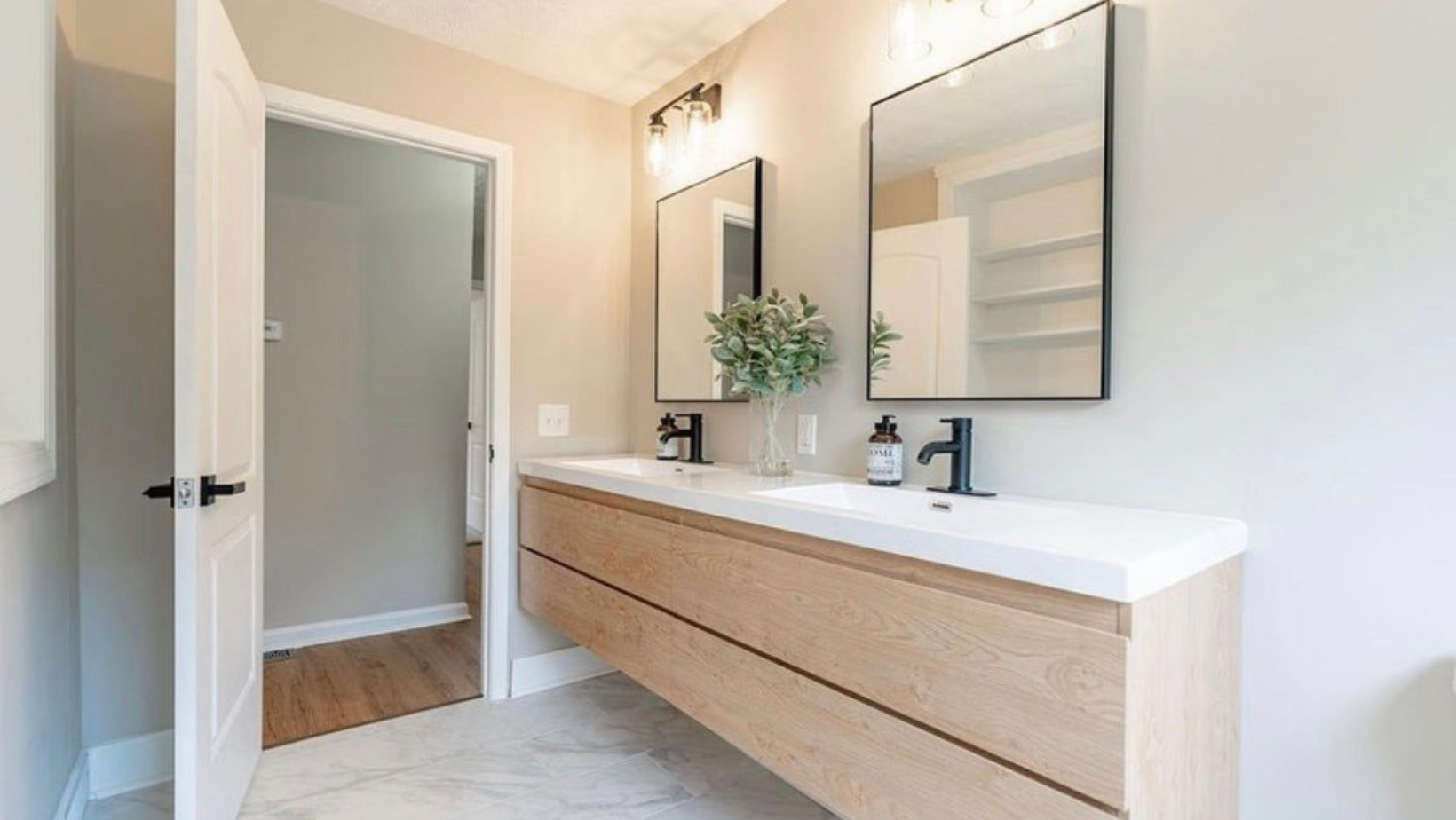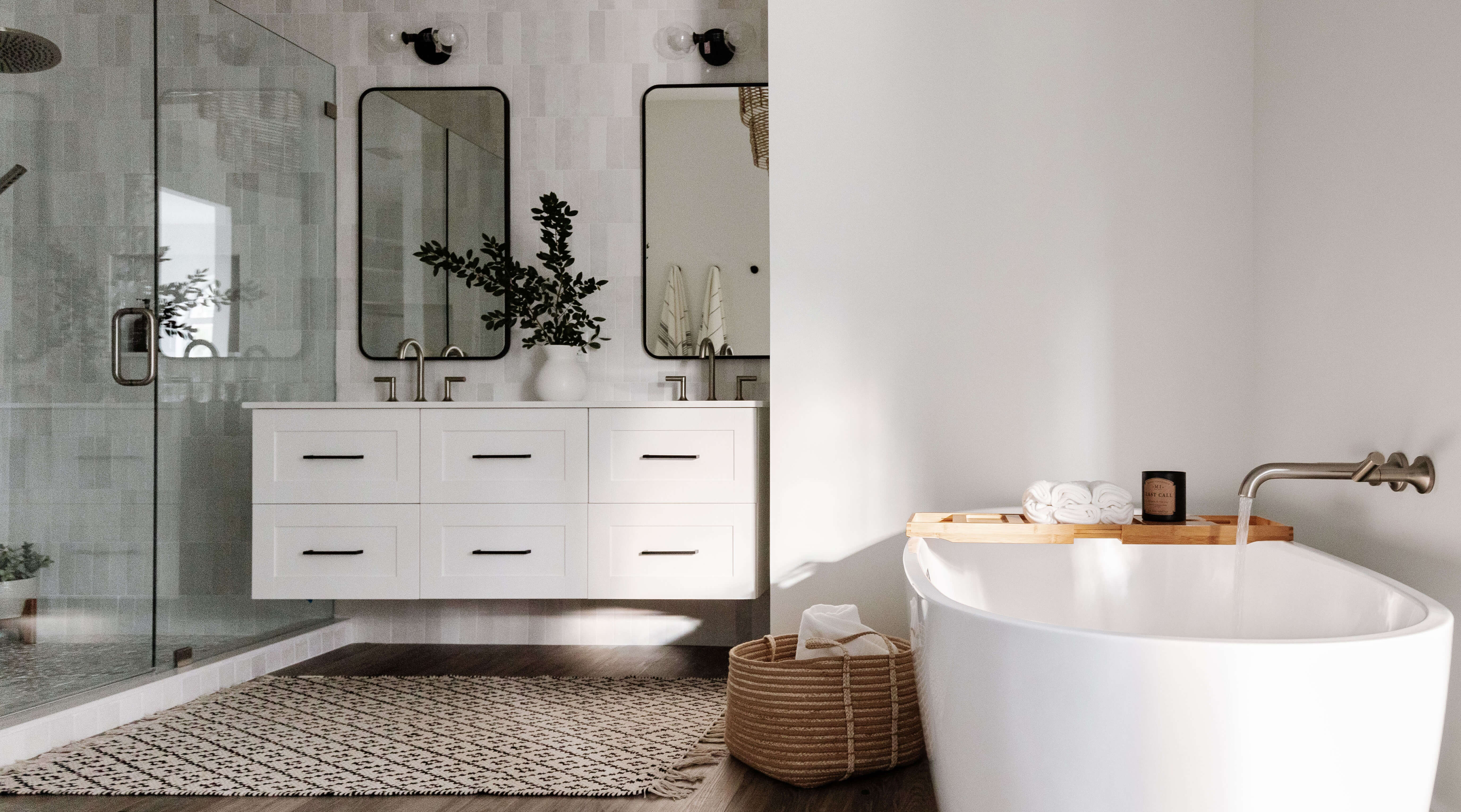Planning and Preparation
/155068606-56a4a2985f9b58b7d0d7ef19.jpg)
Installing a new bathroom vanity is a great way to upgrade your bathroom’s style and functionality. Before you start the installation process, it’s essential to plan carefully and prepare your bathroom for the project. This ensures a smooth and successful installation.
Types of Bathroom Vanities
Bathroom vanities come in a wide variety of styles, materials, and sizes to suit different preferences and bathroom spaces. Understanding the different types available can help you choose the right vanity for your needs.
- Traditional Vanities: These vanities often feature classic designs with ornate details, such as carved wood or intricate hardware. They are typically made from solid wood and often have a more formal appearance.
- Modern Vanities: Modern vanities prioritize clean lines, minimalist designs, and sleek finishes. They often incorporate materials like glass, metal, or high-gloss laminates, creating a contemporary aesthetic.
- Contemporary Vanities: These vanities blend elements of modern and traditional styles, offering a balanced look that is both stylish and functional. They may feature simple lines, but with some decorative accents or unique materials.
- Transitional Vanities: Transitional vanities bridge the gap between traditional and modern styles. They offer a comfortable and inviting atmosphere with a timeless appeal. They often feature clean lines and simple details, but with a touch of warmth and elegance.
- Floating Vanities: Floating vanities create a modern and airy look by appearing to float above the floor. They are typically wall-mounted and often feature a sleek and minimalist design. These vanities can be particularly beneficial for small bathrooms, as they make the space feel larger.
Measuring the Bathroom Space
Accurate measurements are crucial for selecting the right vanity size and ensuring a proper fit. Here’s a step-by-step guide to measuring your bathroom space:
- Determine the Available Wall Space: Measure the width and height of the wall where you plan to install the vanity. Make sure to account for any obstructions, such as pipes or electrical outlets.
- Measure the Existing Plumbing: Locate the existing drain and water supply lines. Measure the distance between the drain and the wall, as well as the distance between the water supply lines and the wall.
- Consider the Vanity Depth: Determine the ideal depth for your vanity, considering the available space and the size of your bathroom. A deeper vanity may provide more storage but could also make the bathroom feel smaller.
- Account for Doors and Drawers: If the vanity has doors or drawers, measure the space needed for them to open fully without obstructing anything.
Tools and Materials
Before you begin the installation process, gather all the necessary tools and materials. This ensures a smooth and efficient project.
- Tools:
- Level
- Tape measure
- Pencil
- Screwdriver
- Drill with drill bits
- Stud finder
- Wrench
- Pliers
- Safety glasses
- Work gloves
- Materials:
- Bathroom vanity
- Vanity top (if not included with the vanity)
- Sink (if not included with the vanity)
- Faucet
- Installation hardware (screws, anchors, etc.)
- Caulk
- Plumbers putty
- Silicone sealant
- Water supply lines (if needed)
- Drain assembly (if needed)
Preparing the Bathroom for Installation
Preparing the bathroom for vanity installation ensures a clean and safe workspace.
- Clear the Area: Remove any existing fixtures, furniture, or items that could obstruct the installation process.
- Turn Off the Water Supply: Locate the main water supply valve for your bathroom and turn it off. This prevents water from leaking during the installation.
- Remove Existing Fixtures: If you’re replacing an old vanity, remove the existing fixtures, including the sink, faucet, and drain assembly.
- Prepare the Wall: If necessary, repair any damage to the wall where the vanity will be installed. Ensure the wall is clean and dry before proceeding.
Vanity Installation: Installing A Vanity In Bathroom

Now that you have prepared the space and gathered your tools, it’s time to install the vanity. This process involves attaching the base to the wall, connecting the sink to the plumbing, and securing the countertop.
Installing the Vanity Base
The vanity base is the foundation of your new bathroom vanity. It’s important to ensure that it is securely attached to the wall to provide stability and prevent tipping.
- Start by positioning the vanity base in the desired location, ensuring it is level and centered.
- Use a stud finder to locate wall studs for attaching the vanity to the wall. This will provide the strongest support.
- Mark the stud locations on the wall using a pencil.
- Drill pilot holes into the marked locations using a drill bit that is slightly smaller than the screws you will use to attach the vanity. This will prevent splitting the wood.
- Align the vanity base with the marked holes and secure it to the wall using screws. Ensure that the screws are long enough to penetrate through the vanity base and into the wall studs for maximum stability.
- If your vanity base does not have pre-drilled holes for attaching to the wall, you will need to drill your own holes. Use a drill bit that is the same size as the screws you will be using.
Connecting the Vanity Sink
Once the vanity base is installed, you can connect the sink to the plumbing system. This involves attaching the drain and water supply lines.
- Start by attaching the drain line to the sink’s drain opening. Most sinks have a threaded opening for the drain line. You will need to use a wrench to tighten the connection.
- Next, connect the drain line to the drain pipe in the floor. This connection may involve using a trap to prevent sewer gases from entering the bathroom. You will need to use a wrench to tighten the connection.
- Finally, connect the water supply lines to the sink’s faucets. Most sinks have two water supply lines, one for hot water and one for cold water. You will need to use a wrench to tighten the connections.
- Ensure that the water supply lines are securely connected and that there are no leaks. If you notice any leaks, tighten the connections or replace the washers.
Installing the Vanity Countertop
The countertop is an essential part of the vanity, providing a surface for the sink and other bathroom accessories.
- Begin by placing the countertop on top of the vanity base, ensuring it is centered and aligned.
- Most countertops have pre-drilled holes for the sink and faucet. Align the countertop with the sink and faucet holes.
- Secure the countertop to the vanity base using screws or clamps. The method of securing the countertop will vary depending on the type of countertop and vanity base.
- After securing the countertop, apply a sealant around the edges of the countertop to prevent water damage. This will help to protect the countertop from spills and splashes.
Installing the Vanity Mirror and Lighting Fixtures, Installing a vanity in bathroom
The vanity mirror and lighting fixtures are the finishing touches to your new bathroom vanity.
- Start by determining the best location for the vanity mirror. It should be positioned above the vanity base and centered. Consider the height of the mirror and the overall aesthetics of the bathroom.
- Once you have determined the location, use a level to ensure the mirror is straight. Mark the location of the mirror on the wall using a pencil.
- Use a drill and appropriate screws to attach the mirror to the wall. Ensure that the screws are long enough to penetrate the wall and provide secure support.
- Install the lighting fixtures according to the manufacturer’s instructions. Consider the type of lighting you want and the placement of the fixtures. You may want to choose fixtures that provide both ambient and task lighting.
- When choosing lighting fixtures, consider the style of your bathroom and the overall lighting needs. You may want to choose fixtures that provide both ambient and task lighting.
Finishing Touches

The final steps of installing a vanity involve ensuring its cleanliness, functionality, and aesthetic appeal. By taking the time to complete these finishing touches, you can create a bathroom space that is both practical and visually pleasing.
Cleaning and Sealing
After the installation is complete, it’s essential to thoroughly clean the vanity to remove any dust, debris, or residue from the installation process. Use a mild cleaner and a soft cloth to wipe down the surfaces, paying special attention to the countertop and sink. Sealing the vanity countertop is a crucial step, especially if it’s made of natural stone. Sealing helps protect the countertop from stains, scratches, and water damage, ensuring its longevity and beauty. Apply a sealant according to the manufacturer’s instructions, allowing it to dry completely before placing any items on the countertop.
Connecting to the Electrical System
Connecting the vanity to the electrical system involves installing the vanity light fixture. This step requires a basic understanding of electrical wiring and safety precautions. Before working with any electrical wiring, always turn off the power at the circuit breaker.
- Identify the wiring: Locate the electrical box for the vanity light fixture and identify the wires. Typically, you’ll find a black wire (hot), a white wire (neutral), and a green or bare copper wire (ground).
- Connect the wires: Connect the wires from the vanity light fixture to the corresponding wires in the electrical box. Ensure a secure connection by using wire connectors.
- Turn on the power: Once the wires are connected, turn the power back on at the circuit breaker and test the vanity light fixture.
It’s crucial to follow local electrical codes and consult a qualified electrician if you are unsure about any aspect of the electrical work.
Decorating and Personalizing
The vanity area offers an opportunity to add personality and functionality to your bathroom. Here are some tips for decorating and personalizing the vanity area:
- Storage solutions: Utilize storage solutions to keep the vanity organized and clutter-free. Consider using drawer organizers, trays, and baskets to separate items and make them easily accessible.
- Accessories: Add decorative touches with accessories such as soap pumps, toothbrush holders, and tissue box covers. Choose items that complement the style of your vanity and bathroom.
- Mirrors: A mirror above the vanity is essential for both functionality and aesthetics. Choose a mirror that complements the size and style of the vanity and adds visual interest to the space.
- Lighting: Adequate lighting is crucial for a well-lit and functional vanity area. Consider adding a vanity light fixture, sconces, or a combination of both.
- Plants: Add a touch of nature with a small plant or two. Choose plants that thrive in humid environments, such as peace lilies or spider plants.
Vanity Styles and Design Elements
| Vanity Style | Design Elements | Advantages | Disadvantages |
|---|---|---|---|
| Traditional | Ornate details, carved wood, pedestal sinks | Elegant, timeless, adds a touch of sophistication | Can be expensive, may not be suitable for small bathrooms |
| Modern | Clean lines, minimalist design, sleek materials | Contemporary, spacious, easy to maintain | Can be cold and sterile, may not be suitable for traditional settings |
| Contemporary | Geometric shapes, bold colors, innovative materials | Unique, expressive, makes a statement | May not be suitable for all styles, can be difficult to match |
| Rustic | Reclaimed wood, distressed finishes, natural elements | Warm, inviting, creates a cozy atmosphere | May not be suitable for modern settings, can be difficult to maintain |
